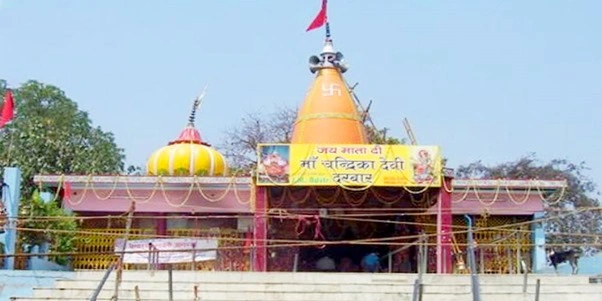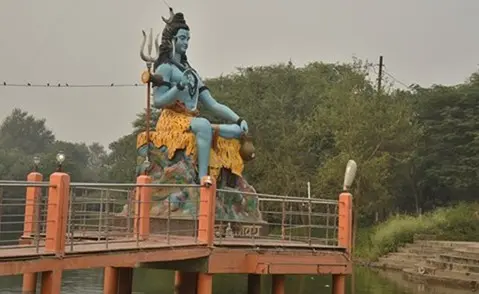Nestled in the serene outskirts of Lucknow, Uttar Pradesh, the Chandrika Devi Temple stands as a testament to India’s rich cultural and spiritual heritage. This ancient shrine, dedicated to Goddess Chandrika Devi, a form of Goddess Durga, attracts thousands of devotees and tourists each year. Let us embark on a virtual journey to uncover the mystique, history, and significance of this revered temple.

The Legend and History
The Chandrika Devi Temple’s origins are steeped in legend and history, dating back approximately 300 years. It is believed that Rajkumar Chandraketu, the elder son of Shri Lakshmana and the founder of Lucknow, once sought refuge and prayed to the Goddess during his travels. In response, the Goddess appeared, bathing the area in moonlight and assuring him of safety.
The original grand temple, established in that era, was unfortunately destroyed by foreign invaders in the 12th century. However, around 250 years ago, villagers rediscovered the deity hidden within the dense forests, leading to the construction of the current temple.
The Chandrika Devi Temple’s architecture.
The Chandrika Devi Temple is a splendid example of traditional Hindu architecture, reflecting the artistic heritage of the Awadh region. The temple is constructed with red sandstone and marble, which gives it a distinctive and regal appearance. It features a dome-shaped roof and a spire, typical of North Indian temple design.
The temple’s main idol, carved out of rock, is a unique representation of Goddess Durga with three heads, symbolizing a combined manifestation of Goddesses Kali, Lakshmi, and Saraswati. This triune form is a rare sight and holds great significance for the devotees.
Within the temple complex, there is a spacious courtyard that houses a large pond and a statue of Lord Shiva, adding to the spiritual ambiance of the place. The presence of the pond, known as Sudhanva Kund or Mahisagar Tirtha, is not only aesthetically pleasing but also carries religious importance as it is used for sacred rituals.

The temple’s location, surrounded by the river Gomti on three sides, enhances its serene and tranquil setting, making it a perfect spiritual retreat for pilgrims and visitors.
Overall, the Chandrika Devi Temple’s architecture is a harmonious blend of spirituality, history, and natural beauty, creating an atmosphere that is both uplifting and peaceful.
Rituals and Festivities
The Chandrika Devi Temple is renowned for its vibrant and spiritual rituals that attract devotees from all over. Here are some of the key rituals performed at this sacred site:
Chandika Yagya: This is the most sacred ritual of the temple, performed on every Amavasya (new moon day). It involves a series of offerings and chants to invoke the blessings of Goddess Chandrika.
Navratri Celebrations: Navratri, the ‘nine nights’ festival dedicated to Goddess Durga, is celebrated with great fervor. The temple observes this occasion twice a year, in the months of Chaitra (March-April) and Ashwin (September-October). During Navratri, the temple becomes a hub of religious activities, with special pujas, aartis, and offerings made to the Goddess.
Daily Aartis: The temple conducts four aartis each day, which are the main rituals of the temple. These aartis are performed at specific times and are central to the daily worship at the temple.
Hawan and Mundan: On special days like Amavasya and Navratri, it’s common to see devotees engaging in ‘hawan’ (fire ritual) and ‘mundan’ (hair offering). These rituals are performed as acts of devotion and surrender to the divine.
Festive Fairs: To mark the importance of special days, a grand fair is organized at the temple in March/April and October/November. These fairs are not only religious gatherings but also cultural events that bring together people from various walks of life.
These rituals are an integral part of the temple’s tradition, providing a way for devotees to express their faith and seek blessings from the Goddess. The temple’s serene atmosphere and the rhythmic chants during these rituals create a truly divine experience for all who visit.
Opening time of the Temple
The Chandrika Devi Temple welcomes visitors daily from 5:00 AM to 1:00 PM and then from 2:00 PM to 11:00 PM. Special aarti timings are at 6:00 AM, 1:00 PM, and 7:00 PM. During Navratri, the temple closes for an hour from 7:00 PM to 8:00 PM before the evening aarti.
Travel Tips
Plan Your Visit: The Chandrika Devi Temple is about 28 km away from the main city of Lucknow and approximately 45 km from Lucknow Airport.
Transport: There is no direct public transport to the Chandrika Devi Temple; visitors may need to hire a private taxi or use their own vehicle.
Accommodation: Various accommodations are available near the temple, from budget-friendly dharamshalas to comfortable hotels.
Respect the Sanctity: Visitors are advised to dress modestly and respect the local customs and traditions.
- Mankameshwar Mandir, Lucknow : A Divine Legacy on the Banks of the Gomti
- Alopi Devi Mandir, Prayagraj: A Blend of Faith and Legend
- Maa Sharda Temple, Maihar: Exploring the Divine
Epilogue
The Chandrika Devi Temple is more than just a place of worship; it is a sanctuary where faith, history, and spirituality converge. Whether you are a devout follower seeking divine blessings or a curious traveler exploring India’s spiritual landscape, the temple offers an enriching and unforgettable experience. The tranquil ambiance, the rich heritage, and the unwavering faith of the devotees make the Chandrika Devi Temple a must-visit destination for anyone seeking solace and spiritual rejuvenation.
So, the next time you find yourself in the heart of Uttar Pradesh, make sure to visit the Chandrika Devi Temple and immerse yourself in its divine aura. Let the blessings of Goddess Chandrika Devi guide you on your journey of life.
1 thought on “Chandrika Devi Temple: Embracing the Divine in Lucknow’s Ancient Sanctuary”